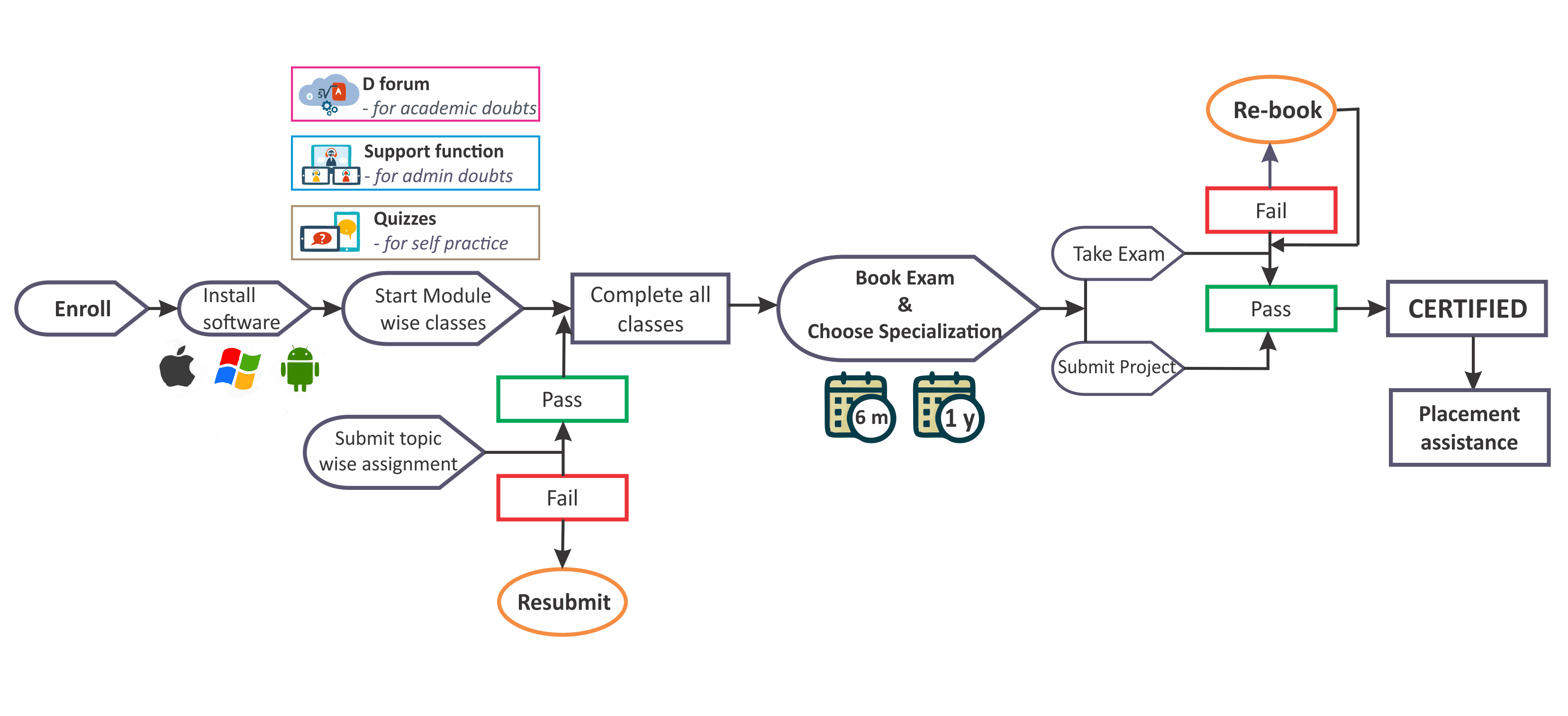BOOTCAMP Risk and AI by GARP
No content
| Sln | Topic | Details | ||
| Module 1 - Primer | ||||
| 01 | Introduction to Machine Learning | What is Machine Learning Types of Learning (Supervised, Unsupervised, Reinforced) Structured vs Unstructured Data Applications of Machine Learning in Real Life |
||
| 02 | Math toolbox for ML | Linear Algebra Vector Algebra (Addition, Product, Projections) Matrix Algebra (Transpose, Multiplication, Inverse, Eigen Values) Optimization Maxima and Minima (calculus based) Lagrangian Multipliers Gradient Descent Parameter Estimation Maximum Likelihood Method (MLE) Maximum a Posteriori (MAP) |
||
| 03 | Getting Started with Python | Python basic data types - CRUD Numpy Python Plotting Pandas Probability & Stats in python Regression in Python. Time Series in Python Monte Carlo Simulations in Python |
||
| Module 2 – Predictive Analytics | ||||
| 04 | Linear Regression | Ways to estimate coefficients in Regression Model Simple vs Multiple Linear Regression Regression Assumptions (Multicollinearity, OVB, Serial Correlation, Hateroscedasticity) Stepwise regression |
||
| 05 | Types of Regression | Principal Component Regression MCMC Kalman Regression |
||
| 06 | Time Series Model | Checking Stationarity of Data Deterministic, Stochastic Trend & Seasonality Autocorrelation & Partial Autocorrelation Functions Fitting ARIMA models LSTM - Long Short Term Memory |
||
| Module 3 – Supervised Learning (Classification) | ||||
| 07 | Decision Boundary Algorithms | Linear Discriminant Analysis Linear SVM Non Linear SVM Kernel SVM |
||
| 08 | Logistic Regression | Logistic Regression | ||
| 09 | Decision Trees | Classification Trees Regression Trees Stooping & Pruning Criterias |
||
| 10 | KNN | Distance Measures K- Nearest Neighbour |
||
| 11 | Neural Networks | Gradient Descent Forward Propoagation Backward Propagation |
||
| 12 | Classification Model Selection and Performance | ROC & CAP Curve Confusion Matrices |
||
| Module 4 – Supervised Learning (Regression) | ||||
| 13 | Bias vs Variance Trade Off | K Fold Cross Validation | ||
| 14 | Regularisation techniques | Lasso Ridge Elastic Net |
||
| Module 5 – Unsupervised Learning | ||||
| 15 | Dimensionality Reduction | Principal Component Analysis (PCA) | ||
| 16 | Clustering | Hierarchical Clustering K-Means Clustering Partitive Clustering |
||
| Module 6 – Reinforcement Learning | ||||
| 17 | Markov Decision Proces | State, Action, Rewards Matrix | ||
| 18 | Model based Learning vs Model Free Learning | Analytical Solution Iterative Procedure Random Exploration & Exploitation Utility Based Method |
||
| 19 | On Policy Evaluation vs Off Policy Evaluation | Utility Based Method SARSA | ||
| Module 7 – Natural Language Processing (NLP) | ||||
| 20 | Data Preparation | Cleaning Regex |
||
| 21 | Data Wrangling | Tokenisation Normalisation Bag of Words n- Grams Lowercasing Stop words Stemming Document Term Matrix |
||
| 22 | Exploratory Data analysis | Term Frequency (Word Cloud) Document Frequency |
||
| 23 | Feature selection | Chi Sq Test Mutual Information |
||
| 24 | Feature Engineering | n-Grams POS Name entity recognition |
||
| 25 | Model Training & Validation | |||
ABOUT THE TRAINER

Karan is a highly skilled & knowledgeable Corporate trainer with 5+ years of total work experience spanning across Financial Modelling & Data Analytics. Known for having a knack for problem solving, thought leadership, highly analytical mindset, intrapreneurship, solid fundamentals & learning aptitude. Spearheaded several solution accelerators and spreadsheet based prototypes in Risk and Analytics space.
Satya is an IIT and IIM alumni with 8+ years of total work experience spanning across Financial Risk consulting and project management and strategy. Worked as SME and Lead in Various finance, risk, regulatory engagements and complex data migraflon project. Adept in BASEL, FRTB capital calculations, model development and machine learning.

Ans 1. There are no pre-requisite to attend this program. Basic knowledge of statistics is required but not compulsory
Ans 2. There are dedicated maths primers and python primers session for those with no maths and coding experience.
Ans 3. It is a 100% practical program with dozens of case studies and spreadsheet models. The approach of delivering the concepts is application based to make you a right fit for data analytics profile.
Ans 4. If you appear for the FDP exam, you will get the certificate from CAIA. However we also offer a Bootcamp in ML certificate after completion of all topic wise assignments, final project and passing MCQ based exam.
Ans 5. You can take either 1 year access or lifetime access. Please note that lifetime access is chargeable extra
Ans 6. With this website we have integrated a customized P2T player that will allow you to play encrypted classes. There are no limitations on the number of views. Also the software is compatible with Windows, Mac, Android or iPhone
Ans 7. To interact with the trainer we have a dedicated forum ‘D-forum’. Any questions asked on D-forum are expected to be replied within 24 hours by trainers and team of moderators & experts.
Ans 8. Every class is supported by PDF notes and excel sheets. All these are available in the course section only.
No content
| Sln | Topic | Details | ||
| Module 1 - Primer | ||||
| 01 | Introduction to Machine Learning | What is Machine Learning Types of Learning (Supervised, Unsupervised, Reinforced) Structured vs Unstructured Data Applications of Machine Learning in Real Life |
||
| 02 | Math toolbox for ML | Linear Algebra Vector Algebra (Addition, Product, Projections) Matrix Algebra (Transpose, Multiplication, Inverse, Eigen Values) Optimization Maxima and Minima (calculus based) Lagrangian Multipliers Gradient Descent Parameter Estimation Maximum Likelihood Method (MLE) Maximum a Posteriori (MAP) |
||
| 03 | Getting Started with Python | Python basic data types - CRUD Numpy Python Plotting Pandas Probability & Stats in python Regression in Python. Time Series in Python Monte Carlo Simulations in Python |
||
| Module 2 – Predictive Analytics | ||||
| 04 | Linear Regression | Ways to estimate coefficients in Regression Model Simple vs Multiple Linear Regression Regression Assumptions (Multicollinearity, OVB, Serial Correlation, Hateroscedasticity) Stepwise regression |
||
| 05 | Types of Regression | Principal Component Regression MCMC Kalman Regression |
||
| 06 | Time Series Model | Checking Stationarity of Data Deterministic, Stochastic Trend & Seasonality Autocorrelation & Partial Autocorrelation Functions Fitting ARIMA models LSTM - Long Short Term Memory |
||
| Module 3 – Supervised Learning (Classification) | ||||
| 07 | Decision Boundary Algorithms | Linear Discriminant Analysis Linear SVM Non Linear SVM Kernel SVM |
||
| 08 | Logistic Regression | Logistic Regression | ||
| 09 | Decision Trees | Classification Trees Regression Trees Stooping & Pruning Criterias |
||
| 10 | KNN | Distance Measures K- Nearest Neighbour |
||
| 11 | Neural Networks | Gradient Descent Forward Propoagation Backward Propagation |
||
| 12 | Classification Model Selection and Performance | ROC & CAP Curve Confusion Matrices |
||
| Module 4 – Supervised Learning (Regression) | ||||
| 13 | Bias vs Variance Trade Off | K Fold Cross Validation | ||
| 14 | Regularisation techniques | Lasso Ridge Elastic Net |
||
| Module 5 – Unsupervised Learning | ||||
| 15 | Dimensionality Reduction | Principal Component Analysis (PCA) | ||
| 16 | Clustering | Hierarchical Clustering K-Means Clustering Partitive Clustering |
||
| Module 6 – Reinforcement Learning | ||||
| 17 | Markov Decision Proces | State, Action, Rewards Matrix | ||
| 18 | Model based Learning vs Model Free Learning | Analytical Solution Iterative Procedure Random Exploration & Exploitation Utility Based Method |
||
| 19 | On Policy Evaluation vs Off Policy Evaluation | Utility Based Method SARSA | ||
| Module 7 – Natural Language Processing (NLP) | ||||
| 20 | Data Preparation | Cleaning Regex |
||
| 21 | Data Wrangling | Tokenisation Normalisation Bag of Words n- Grams Lowercasing Stop words Stemming Document Term Matrix |
||
| 22 | Exploratory Data analysis | Term Frequency (Word Cloud) Document Frequency |
||
| 23 | Feature selection | Chi Sq Test Mutual Information |
||
| 24 | Feature Engineering | n-Grams POS Name entity recognition |
||
| 25 | Model Training & Validation | |||

Karan is a highly skilled & knowledgeable Corporate trainer with 5+ years of total work experience spanning across Financial Modelling & Data Analytics. Known for having a knack for problem solving, thought leadership, highly analytical mindset, intrapreneurship, solid fundamentals & learning aptitude. Spearheaded several solution accelerators and spreadsheet based prototypes in Risk and Analytics space.
Satya is an IIT and IIM alumni with 8+ years of total work experience spanning across Financial Risk consulting and project management and strategy. Worked as SME and Lead in Various finance, risk, regulatory engagements and complex data migraflon project. Adept in BASEL, FRTB capital calculations, model development and machine learning.

Ans 1. There are no pre-requisite to attend this program. Basic knowledge of statistics is required but not compulsory
Ans 2. There are dedicated maths primers and python primers session for those with no maths and coding experience.
Ans 3. It is a 100% practical program with dozens of case studies and spreadsheet models. The approach of delivering the concepts is application based to make you a right fit for data analytics profile.
Ans 4. If you appear for the FDP exam, you will get the certificate from CAIA. However we also offer a Bootcamp in ML certificate after completion of all topic wise assignments, final project and passing MCQ based exam.
Ans 5. You can take either 1 year access or lifetime access. Please note that lifetime access is chargeable extra
Ans 6. With this website we have integrated a customized P2T player that will allow you to play encrypted classes. There are no limitations on the number of views. Also the software is compatible with Windows, Mac, Android or iPhone
Ans 7. To interact with the trainer we have a dedicated forum ‘D-forum’. Any questions asked on D-forum are expected to be replied within 24 hours by trainers and team of moderators & experts.
Ans 8. Every class is supported by PDF notes and excel sheets. All these are available in the course section only.